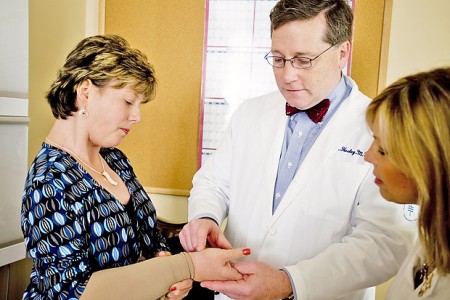
It is a disease that causes an abnormal growth of cells, within the bone. Here are certain myths that are believed regarding it.
Only old people develop bone cancerThe myth derives strength from the fact that the old and elderly suffer weakening in bones and that many other bone-related illnesses have higher incidence among them. However, this cannot be considered as true in the case of cancers. Osteosarcoma is the most common kind of bone cancer which comprises almost 20 percent of all the bone cancers. It occurs only in children and is estimated to affect almost 5 million people under 20 years of age in the United States alone. Another rare form of bone tumor, Ewing sarcoma, affects the teenagers mostly in the pelvis, ribs, humerus and clavicle. So youngsters too are susceptible to bone tumor and cancer.Injuries can cause bone tumorsInjuries bring with them a heightened awareness towards the affected areas. For instance, when one suffers a fracture in the leg, one tends to be more careful about the leg. The fracture makes one more conscious about any future symptoms that occur in that leg and this often leads to a correct diagnosis. This mistakenly has lead to the myth that having cuts, bruises, injuries and especially broken bones lead to the development of bone tumors. This is as false as assuming that a hit to the breast causes breast cancer! This much is true that a hit on a tumorous bone may cause greater pain than in normal circumstances.All bone tumors are cancerous and thus dangerousThe word ‘tumor’ in itself arouses fear and anxiety in people. That might be the major reason why this myth has held water for so long. It is only the tumors which metastasize that grow into cancers. Otherwise, the tumor is termed as a benign one. The fear factor is such that people often equate tumor with cancer which is not true at all. Most tumors and benign which means that they do not grow uncontrollably. They are thus harmless to the body. In fact, the moles that we see so commonly on different parts of the body are examples of benign tumors.Diagnosis of bone cancer automatically means amputationCancer spreads uncontrollably and if it is not checked well in advance, nothing can stop its advance. That is what makes the disease so deadly and feared. Popular literature has many scary stories of cancer and the English language uses the word to refer to an uncontrolled explosion or growth. Thus, anybody diagnosed with bone cancer has the tendency to feel that the affected limb has to be amputated because the bone, which is the very foundation of the limb, has been affected. While amputation may be required in some cases to treat bone cancer and prevent it from spreading to other areas, amputation is fast being replaced by chemotherapy and radiotherapy.Surgery increases bone cancer and spreads it to other areas by exposing it to airMany fungal, bacterial and fungal infections spread through exposure via air because they are caused by micro-organisms. Cancer is a deadly ‘infection’ but is not caused by microbes. Apart from this fact, the myth might have gained strength because of some common occurrences during surgery. During surgery, if it is determined, for instance, that the cancer has spread to lymph nodes, these nodes will be removed as well. Thus, additional surgery is required to remove cancers which have already spread to parts of the body which were not previously determined. This could have led to the myth. Belief in this myth affects the treatment because the patient becomes skeptical and fearful of the surgery and may refuse to go through it.Bone cancer treatments have side effects like losing hair, vomiting and nausea and radiation is thus a painful processThis myth has definitely arisen from the various websites, helplines and support groups that provide general information on cancer. In the bid to mentally prepare the patient, they provide guidelines of what he/she can expect due to the treatment. The ‘probable’ part is forgotten and it is wrongly assumed that all tumor treatments result in same side effects. The side effects depend on the kind of treatment and also the constitution of the individual patient. Again, all the talk about ‘harmful radiation’ makes one fear the term ‘radiation’ itself. Radiation treatment is often as painless as taking an X-Ray. Modern technology has ensured that oncologists are able to focus precisely on the cancerous cells, sparing the healthy tissue.Radiation treatment make a person radioactiveWhen there is a nuclear leak, the whole area is cordoned off to prevent radiation leak. The materials in the vicinity are isolated because they are contaminated and emit radiations. Warnings are issued alerting people to be wary of radioactive substances. This might have given birth to the belief that a person receiving radiation treatment too becomes radioactive! The body is not a battery and it does not store or emit the radiations. So, there is no need to restrain from hugging, kissing, touching or even having sexual relations with a patient receiving radiation treatment. Radiation treatment definitely does not make the patient radioactive!




